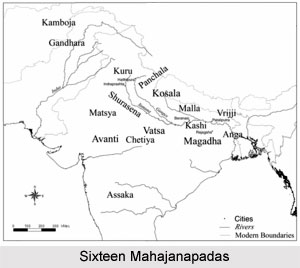 Sixteen Mahajanapadas of ancient India includes Vajji as one of them. The Vajji was a confederation of many clans of which the Lichchhavis, the Vedehans, Jnatrikas and the Vajjis were the most important. It was actually known as the Vajji Sangha or the union of Vajji, which comprised of many janapadas, gramas (villages), gosthas (groups). The eminent people were chosen from each khandas (districts) to represent on their behalf in Vajji gana parishad (people`s council of Vajji). The chairman of the council was called Ganapramukh (head of the democracy), but often he was addressed as the king. The other executives were Mahabaladhrikrit (equivalent to the minister of internal security), binishchayamatya (chief justice), dandadhikrit (other justices) etc. Vajji had its capital at Vaishali.
Sixteen Mahajanapadas of ancient India includes Vajji as one of them. The Vajji was a confederation of many clans of which the Lichchhavis, the Vedehans, Jnatrikas and the Vajjis were the most important. It was actually known as the Vajji Sangha or the union of Vajji, which comprised of many janapadas, gramas (villages), gosthas (groups). The eminent people were chosen from each khandas (districts) to represent on their behalf in Vajji gana parishad (people`s council of Vajji). The chairman of the council was called Ganapramukh (head of the democracy), but often he was addressed as the king. The other executives were Mahabaladhrikrit (equivalent to the minister of internal security), binishchayamatya (chief justice), dandadhikrit (other justices) etc. Vajji had its capital at Vaishali.
According to Dr. Rhys David this state is comprised of eight tribes, the most important of them were Chavi, Videha and Gyatrik. During the lifetime of lord Buddha it was an independent state but later on was conquered by Ajatsatru who merged in Magadha as well



















